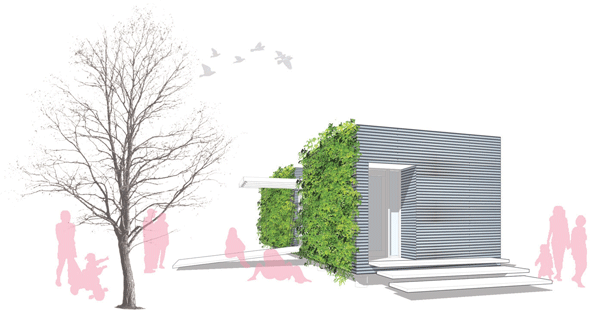
Image Credit: Rice University
The Solar Decathlon team from Texas offers a peek at its entry for the fall contest
We’re still five months from the kickoff of the 2009 Solar Decathlon, which will run October 8-18 in Washington, D.C. But one of the 20 teams of university students selected to compete is offering the public a preview of its entry, an 800-square-foot structure called the Ze-Row House.
It’s a short preview. From noon to 3:30 p.m. Friday (May 8), the Rice University team (the only Decathlon competitor from Texas) will lead tours of the house at its construction site on the Rice campus (6100 Main Street, near the corner of College Way and Alumni Drive, if you happen to be visiting or live in Houston).
As we noted in a previous GBA news blog, Solar Decathlon teams are selected by a committee of engineers, scientists, and other experts from the Department of Energy and its National Renewable Energy Laboratory, who review prospective entrants’ proposals for creating highly energy efficient, solar-powered homes at relatively low cost. Over a two-year period, the 20 teams chosen to compete further develop their proposals and eventually bring them to life on the National Mall.
Each Solar Decathlon team competes in 10 areas: architecture (for a maximum of 100 points), market viability (100 points), engineering (100 points), lighting design (75 points), communications (75 points), comfort zone (100 points), hot water (100 points), appliances (100 points), home entertainment (100 points), and net metering (150 points).
It is not uncommon for teams to develop, transport, and assemble their projects at a cost of $500,000 or more. But because its house is designed to serve low-income residents in Houston’s Third Ward, the Rice team has been working with much narrower economic strictures. It’s Ze-Row House, which was developed in consultation with local nonprofit arts and culture group Project Row Houses, was created with a building and materials budget of about $150,000, so that its design and concepts could be replicated in six energy-efficient, one- and two-bedroom homes on two 50-by-80-foot lots in Houston’s Third Ward.
More than 100 members of the Rice community, from a variety of disciplines, worked on the Ze-Row house, which is the latest project in an affordable-housing initiative and long-term collaboration between Project Row Houses and the Rice Building Workshop, a program that allows students to turn ideas into actual construction projects.
Weekly Newsletter
Get building science and energy efficiency advice, plus special offers, in your inbox.














0 Comments
Log in or create an account to post a comment.
Sign up Log in